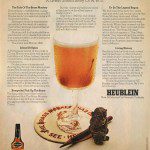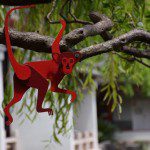Cocktail of the Month: The Year of the Monkey
By • March 18, 2016 0 3727

Along with the hope of an early spring from Punxsutawney Phil, February also ushered in the Lunar New Year. 2016 is the Year of the Monkey, which is also my Chinese zodiac sign. In accordance, I have decided this should be a year of celebration, requiring a signature “monkey” cocktail.
Perhaps the best-known tipple with a primate name is the brass monkey, which was made famous, or infamous, by the Beastie Boys song of the same name in the 1980s.
The brass monkey wasn’t necessarily something you would order at a bar; it was a premixed bottled cocktail manufactured by the Heublein Company and sold in retail liquor stores.
A magazine ad from the 1970s tells the story of a World War II spy named H.E. Rasske who frequented a bar called the Brass Monkey in Macau. The bar was named for a brass figurine and its specialty was its self-named cocktail.
While the contents of the drink at the fictional Asian club are unknown, Heublein’s version contained orange juice, dark rum and vodka. Dark rum, when mixed with the orange juice, produced a golden “brassy color.” Variations of this recipe sometimes include triple sec, grapefruit juice, Galliano and gin.
Other chimp cocktails exist. Many of them are sweet creamy concoctions made with bananas (no doubt because of the fruit’s identification as the preferred primate provender).
For example, the mocha monkey, created by Baileys liqueur, is a frozen drink composed of Baileys, vanilla ice cream, chocolate syrup and fresh banana. A slightly more potent concoction is the cheeky monkey, made with Baileys, crème de cacao and crème de banana.
The funky monkey, marketed by Bacardi, is a similar drink with the substitution of rum and coconut cream for the Baileys.
Absinthe is another common factor in monkey cocktails, perhaps due to the antiquated notion of absinthe making drinkers crazy. In 2012, during the height of the gin craze, Esquire magazine published a recipe for the flying monkey, which contained gin, lime, orange marmalade?and absinthe.
Another gin/absinthe combo is the monkey gland, created in the 1920s at Harry’s New York Bar in Paris. According to slakethirst.com, its moniker is derived from an archaic surgical technique of grafting monkey testicle tissue into humans. The practice was started by a French doctor, who was convinced that testosterone was the key to a long and healthy life. A precursor to Viagra, perhaps?
I found my signature monkey drink for 2016 in Singapore, where I went to celebrate Chinese New Year. The streets of Chinatown were illuminated with monkeys holding peaches (which symbolize immortality), and people were jammed into restaurants eating spring rolls and whole fish for good fortune.
In Singapore, I discovered Monkey Shoulder, a blended Speyside malt whisky. The name is a reference to a condition that maltmen from the distillery sometimes picked up while working long shifts, turning the barley by hand. Because this tended to cause their turning arm to hang down a bit like a monkey’s, they nicknamed the condition ‘monkey shoulder.’
Straight up, this scotch has a mild taste with hints of nutmeg and honey. The promotional materials claim it tastes like 007 wearing a tuxedo wetsuit. I also tried the ginger monkey, an uncomplicated mixture of scotch, ginger beer and orange. In Chinese culture, displaying and consuming oranges is said to bring wealth and luck (plus the spice of the ginger beer gives this cocktail an Asian twist).
If none of these tipples tickles your fancy, you can still toast the Year of the Monkey by garnishing your drinks with tiny plastic cocktail monkeys — miniature versions of the characters from your childhood game, Barrel of Monkeys. Vanity Fair last year declared the plastic cocktail monkey the “new cocktail umbrella.”
- Yelp



